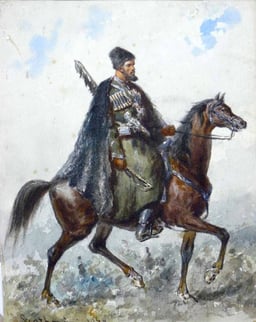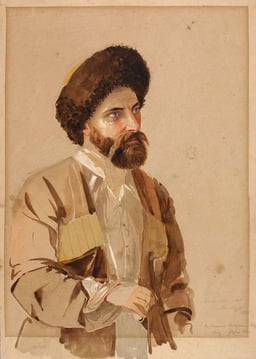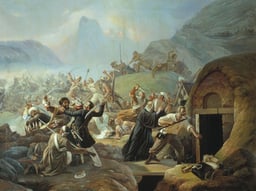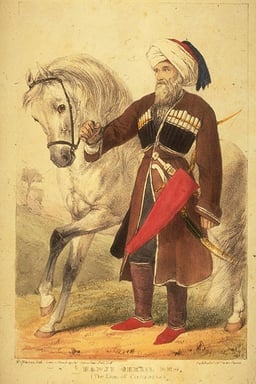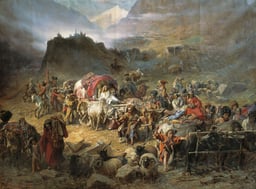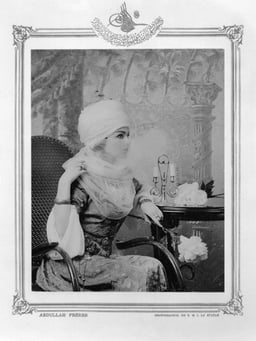Circassians
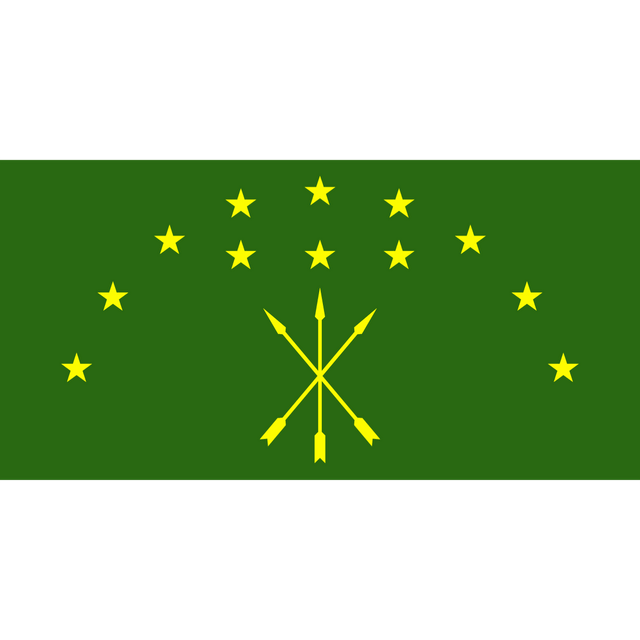
Circassians

| Total population | |
|---|---|
| c. 4–8 million | |
| Regions with significant populations | |
| Estimated 1,000,000[1]–2,000,000[2][3]–3,000,000[4]–5,000,000[2][5] to 7,000,000[6] | |
| 718,729 (2010 Census)[7] | |
| 65,000[8] | |
| 80,000[8][9][10]–120,000[11] | |
| 40,000[8][12] | |
| 34,000 | |
| 9,000[8]–25,000 | |
| 23,000 | |
| 12,000 | |
| 4,000[13][14]–5,000[15] | |
| 1,257 (1989 census)[16] | |
| 1,001 (2001 census)[17] | |
| 834 (2011 Census)[18] | |
| 500[19] | |
| 116 (2009 census)[20] | |
| 54 (1995 census)[21] | |
| 52 (2019 statistics)[22] | |
| Languages | |
| Circassian (West Adyghe, Kabardian Adyghe, extinct Ubykh Adyghe dialects), also Turkish, Russian, English, Arabic, Hebrew | |
| Religion | |
| Predominantly Sunni Islam Minority Eastern Orthodox Church,[23] Catholicism[24] and Circassian ethnic faith Khabzeism,[25] as well as atheists[26] | |
| Related ethnic groups | |
| Abazgi (Abkhaz, Abazin) | |
The Circassians (Russian: Черкесы Čerkesy), also known by their endonym Adyghe (Circassian: Адыгэхэр Adygekher, Russian: Ады́ги Adýgi), are a Northwest Caucasian[27] ethnic group native to Circassia, many of whom were displaced in the course of the Russian conquest of the Caucasus in the 19th century, especially after the Russo-Circassian War in 1864. The Circassians mainly speak the Circassian languages, a Northwest Caucasian dialect continuum with three main dialects and numerous sub-dialects. Many Circassians also speak Turkish, Russian, English, Arabic and Hebrew, having been exiled by Russia to lands of the Ottoman Empire, where the majority of them today live.[28] Most Circassians are Sunni Muslim.[29]
In its narrowest sense, the term "Circassian" includes the twelve historic Adyghe (Circassian: Адыгэ, Adyge) princedoms of Circassia (three democratic and nine aristocratic); Abdzakh, Besleney, Bzhedug, Hatuqwai, Kabardian, Mamkhegh, Natukhai, Shapsug, Temirgoy, Ubykh, Yegeruqwai and Zhaney,[30] each star on the Circassian flag representing each princedom.
Historical Circassia has been divided by Soviet and Russian administrations into the modern-day titular Circassian republics of Adygea, Kabardino-Balkaria, Karachay-Cherkessia and Krasnodar Krai, as well as southwestern parts of Stavropol Krai and Rostov Oblast. Accordingly, Circassians or Adyghe have also been designated as the following: Adygeans in Adygea, Kabardians in Kabardino-Balkaria, Cherkess in Karachay-Cherkessia,and Shapsug in Krasnodar Krai, although all four are essentially the same people. About 800,000 Circassians remain in historical Circassia, while others live in the Russian Federation outside these republics and krais. The 2010 Russian Census recorded 718,727 Circassians, of whom 516,826 are Kabardian, 124,835 are other Adyghe in Adygea, 73,184 are Cherkess and 3,882 Shapsug.[7]
The Unrepresented Nations and Peoples Organization estimated in the early 1990s that there are as many as 3.7 million "ethnic Circassian" diaspora (in over 50 countries)[31] outside the titular Circassian republics (meaning that only one in seven "ethnic Circassians" live in the homeland), and that, of these 3.7 million, more than 2 million live in Turkey,[31] 300,000 in the Levant (mostly modern-day Jordan and Syria) and Mesopotamia and 50,000 in Western Europe and the United States.
| Total population | |
|---|---|
| c. 4–8 million | |
| Regions with significant populations | |
| Estimated 1,000,000[1]–2,000,000[2][3]–3,000,000[4]–5,000,000[2][5] to 7,000,000[6] | |
| 718,729 (2010 Census)[7] | |
| 65,000[8] | |
| 80,000[8][9][10]–120,000[11] | |
| 40,000[8][12] | |
| 34,000 | |
| 9,000[8]–25,000 | |
| 23,000 | |
| 12,000 | |
| 4,000[13][14]–5,000[15] | |
| 1,257 (1989 census)[16] | |
| 1,001 (2001 census)[17] | |
| 834 (2011 Census)[18] | |
| 500[19] | |
| 116 (2009 census)[20] | |
| 54 (1995 census)[21] | |
| 52 (2019 statistics)[22] | |
| Languages | |
| Circassian (West Adyghe, Kabardian Adyghe, extinct Ubykh Adyghe dialects), also Turkish, Russian, English, Arabic, Hebrew | |
| Religion | |
| Predominantly Sunni Islam Minority Eastern Orthodox Church,[23] Catholicism[24] and Circassian ethnic faith Khabzeism,[25] as well as atheists[26] | |
| Related ethnic groups | |
| Abazgi (Abkhaz, Abazin) | |
Ethnonyms
Adyghe

Circassian warrior
The Circassians refer to themselves as Adyghe (also transliterated as Adyga, Adyge, Adygei, Adyghe, Attéghéi). The name is believed to derive from atté "height" to signify a mountaineer or a highlander, and ghéi "sea", signifying "a people dwelling and inhabiting a mountainous country near the sea coast", or "between two seas".[32][33]
Circassian, Charkas, Cherkes
The word "Circassians" (/sərˈkæsiənz/ sər-KASS-ee-ənz) is an exonym. The Russians referred to all Circassian tribes as Cherkesy, which may be derived from Kerkety, the name of one of the Adyghe tribes native to the northwestern Caucasus.[34] In early Russian sources, the Circassians are referred to as Kasogi, whereas in medieval Arabic sources, Kasogi is written as Jarkas and Jahārkas.[34] The spelling Charkas may be an abbreviation of Persian Chahār-kas ("four people"), denoting four tribes.[34] Though "Jahārkas" was used by Ibn Khaldun (died 1406) and Ali ibn al-Athir (died c. 1232/3), the Persian hypothesis remains uncertain.[34]
In the 10th century, Persians, Georgians and Arabs referred to the Circassians as Kashak, which appears to be a Georgian word derived from Ossetian Kasogi.[34] The Turkic peoples referred to the Circassians as Cherkas, a name which had come into common use by the 13th century.[34] This designation (Cherkas) originally "did not designate the Adygei but rather the people living in southern Ukraine".[34] Even in contemporary times, Ukraine has a province named Cherkessk, with its provincial capital bearing the same name.[34]
With the advent of the Golden Horde in the 13th century, the designation Cherkess "came to refer to the Adygei who remained in the Caucasus, and then became a generic term for all who lived there".[34] This in turn created terminology "anomalies", and as a result, Cherkes became often used alongside other names such as Adygei, Abaza, Kabardian, Karachay, and Abkhaz.[34] In Medieval Oriental and European texts, "the Adygei people were known by the name Cherkess/Circassians".[34]
The Encyclopaedia Islamica adds: "This is because the Cherkess, the Kabardians and the Adygei people share a common language, which is spoken by the north-western Caucasian (Abkhazi) people, and belongs to the family known as Abkhazian-Adygei".[34] In Persian sources, Charkas/Cherkes is used to refer to the "actual" Circassians of the northwest Caucasus, and in some occasions as a general designation for Caucasians who live beyond Derbent (Darband).[35]
In Turkey the term nowadays used as a name for all Caucasian nations such as, such as Karachays, Ossetians, different Dagestanian diasporas and others.[39][40]
Soviet policy
Despite a common self-designation and a common Russian name,[41] Soviet authorities applied four designations to Circassians:
Kabardian, Circassians of Kabardino-Balkaria (Circassians speaking the Kabardian language,[42][43] one of two indigenous peoples of the republic.
Cherkess (Adyghe: Шэрджэс Šărdžăs), Circassians of Karachay-Cherkessia (Circassians speaking the Cherkess, i.e. Circassian, language[42][43] one of two indigenous peoples of the republic who are mostly Besleney Kabardians. The name "Cherkess" is the Russian form of "Circassian" and was used for all Circassians before Soviet times.
Adyghe or Adygeans, the indigenous population of the Kuban including Adygea and Krasnodar Krai.[44]
Shapsug, the indigenous historical inhabitants of Shapsugia. They live in the Tuapse District and the Lazarevsky City District (formerly the Shapsugsky National District) of Sochi, both in Krasnodar Krai and in Adygea.
History
Origins
Genetically, the Adyghe have shared ancestry partially with neighboring peoples of the Caucasus, with some influence from the other regions.[45] The Circassian language, also known as Cherkess, is a member of the ancient Northwest Caucasian language family.
Archaeological findings, mainly of dolmens in Northwest Caucasus region, indicate a megalithic culture in the Northwest Caucasus.[46]
Medieval period
As a result of Armenian, Greek and Byzantine influence, Christianity spread throughout the Caucasus between the 3rd and 5th centuries AD.[47][48] During that period the Circassians (referred to at the time as Kassogs)[49] began to accept Christianity as a national religion, but did not abandon all elements of their indigenous religious beliefs.
From around 400 AD wave after wave of invaders began to invade the lands of the Adyghe people, who were also known as the Kasogi (or Kassogs) at the time. They were conquered first by the Bulgars (who originated on the Central Asian steppes). Outsiders sometimes confused the Adyghe people with the similarly-named Utigurs (a branch of the Bulgars), and both peoples were sometimes conflated under misnomers such as "Utige". Following the dissolution of the Khazar state, the Adyghe people were integrated around the end of the 1st millennium AD into the Kingdom of Alania.
Between the 10th and 13th centuries Georgia had influence on the Adyghe Circassian peoples, with many adopting Christianity.
Early modern period
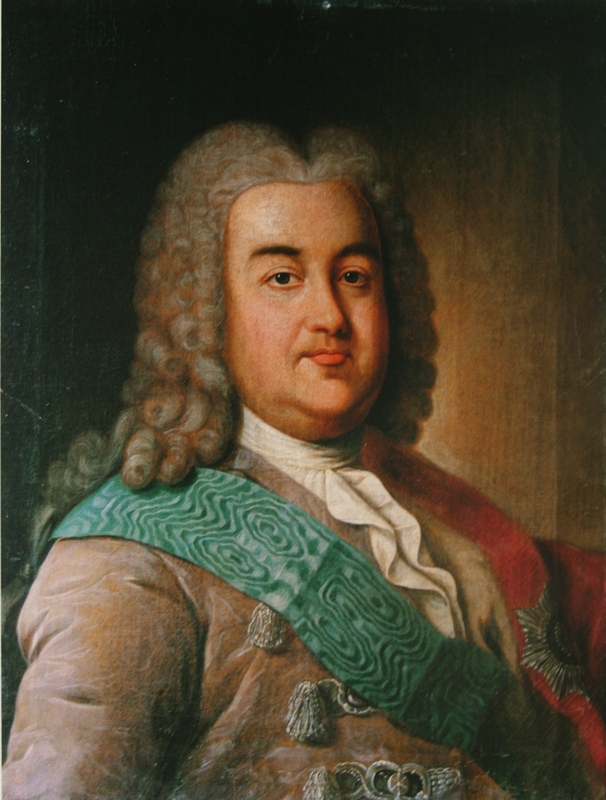
Alexey Cherkassky was the Chancellor of the Russian Empire, descended from the sovereign rulers of Circassia
In the 17th century, under the influence of the Crimean Tatars and of the Ottoman Empire, large numbers of Circassians converted to Islam from Christianity.[50]
In 1708, Qaplan I Giray, a Crimean khan, ordered to have 4,000 Kabardian slaves while ascending to the throne. Kabardians led by Kurgoko Atazhukin were reluctant to pay tribute to the Crimean Khan.[51] Qaplan I Giray along with 20,000 warriors marched to Kabarday to retrieve his demands. While setting a fire camp, Crimean Tatars were attacked by 7,000 cavalry units headed by Prince Kurgoko Atazhukin in the battle of Kinzhal near Malka River.[52]
The Crimean army was destroyed in one night on 17 September 1708. Only a small group of Crimeans headed by Qaplan I Giray managed to escape.[53] In 2013, the Institute of Russian History of the Russian Academy of Sciences recognized that the battle of Kinzhal Mountain with the paramount importance in the national history of Kabardians, Balkarians and Ossetians.[54]
Russian invasion of Circassia
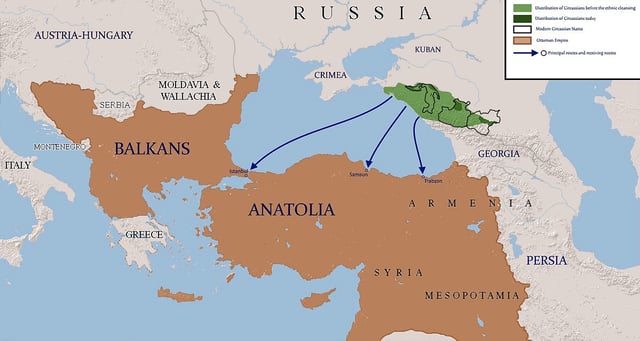
A map of the expulsion of Circassians to the Ottoman Empire. The light-green area denotes the final borders of Circassians who had already been pushed southwards prior to their expulsion to the Ottoman Empire. Note that in the late 18th century the Circassians lost their northern territories, which do not appear in green on this map.
![A Meccan merchant (right) and his Circassian slave. Entitled, ‘Vornehmner Kaufmann mit seinem cirkassischen Sklaven’ [Distinguished merchant and his circassian slave] by Christiaan Snouck Hurgronje, ca. 1888.](https://everipedia.org/cdn-cgi/image/width=640/https://upload.wikimedia.org/wikipedia/commons/0/0f/Meccan_merchant_and_his_Circassian_slave.jpg)
A Meccan merchant (right) and his Circassian slave. Entitled, ‘Vornehmner Kaufmann mit seinem cirkassischen Sklaven’ [Distinguished merchant and his circassian slave] by Christiaan Snouck Hurgronje, ca. 1888.
Between the late 18th and early-to-mid-19th centuries, the Adyghe people lost their independence as the Russian Empire gradually carried out a series of wars and campaigns. During this period, the Adyghe plight achieved a certain celebrity status in the West; but pledges of assistance were never fulfilled. After the Crimean War of 1853 to 1856, Russia turned its attention to the Caucasus in earnest. Following major territorial losses for Persia in the Caucasus in the aftermath of the Russo-Persian War (1804–1813) and the Russo-Persian War (1826–1828), forcing Persia to cede what comprises now Georgia, Dagestan, Armenia, and Azerbaijan to Imperial Russia,[55]
Russia found itself able to focus most of its army on subduing the rebelling natives of the North Caucasus, starting with the peoples of Chechnya and Dagestan. In 1859 the Russians finished defeating Imam Shamil in the eastern Caucasus, and turned their attention westward. Eventually, the long-lasting Russian–Circassian War, which had begun a hundred years earlier, ended with the defeat of the Adyghe forces. Some Adyghe leaders signed loyalty oaths on 2 June 1864 (21 May, O.S.).
The conquest of the Caucasus by the Russian Empire in the 19th century during the Russian-Circassian War led to the destruction and killing of many Adyghe—towards the end of the conflict, the Russian General Nikolai Yevdokimov had the task of driving the remaining Circassian inhabitants out of the region, primarily into the Ottoman Empire. Mobile columns of Russian riflemen and Cossack cavalry carried out the task.[56][57][58]
"In a series of sweeping military campaigns lasting from 1860 to 1864... the northwest Caucasus and the Black Sea coast were virtually emptied of Muslim villagers. Columns of the displaced were marched either to the Kuban [River] plains or toward the coast for transport to the Ottoman Empire... One after another, entire Circassian tribal groups were dispersed, resettled, or killed en masse"[58]
In 1840 Karl Friedrich Neumann estimated the Circassian casualties at around one and a half million.[59] Some sources state that hundreds of thousands of others died during the exodus.[60] Several historians use the phrase "Circassian massacres"[61] for the consequences of Russian actions in the region.[62]
Like other ethnic minorities under Russian rule, the Adyghe who remained in the Russian Empire borders were subjected to policies of mass resettlement.
It has been estimated that the Ottoman Empire, which ruled large parts of the area south of Russia, imported some 200,000 slaves—mainly Circassians—between 1800 and 1909.[63] The Ottoman Empire regarded the Adyghe warriors as courageous and well-experienced. It encouraged them to settle in various near-border settlements of the Ottoman Empire in order to strengthen the empire's borders.
According to Walter Richmond,
"Circassia was a small independent nation on the northeastern shore of the Black Sea. For no reason other than ethnic hatred, over the course of hundreds of raids the Russians drove the Circassians from their homeland and deported them to the Ottoman Empire. At least 600,000 people lost their lives to massacre, starvation, and the elements while hundreds of thousands more were forced to leave their homeland. By 1864, three-fourths of the population was annihilated, and the Circassians had become one of the first stateless peoples in modern history".[64]
Post-exile period
The Adyghe whom the Ottomans settled in various near-border settlements across the Ottoman Empire ended up living across many territories in the Middle East. At the time these lands belonged to the Ottoman Empire; now Adyghes have established communities in the following countries:
Turkey, which has the largest Adyghe population in the world. The Adyghe settled in three main regions in Turkey: Samsun, along the shores of the Black Sea; the region near the city of Ankara, the region near the city of Kayseri, and in the western part of the country near the region of Istanbul. This latter region experienced a severe earthquake in 1999. Many Adyghe played key roles in the Ottoman army and also participated in the Turkish War of Independence of 1919–1923.
Syria – Most of the Adyghe who immigrated to Syria settled in the Golan Heights. Prior to the Six-Day War of 1967, the Adyghe people – then estimated at 30,000 in number – were the majority group in the Golan Heights region. The most prominent settlement in the Golan was the town of Quneitra. The total number of Circassians in Syria is estimated at between 50,000 and 100,000.[65] In 2013, as tensions between the Baath government and the opposition forces escalated, Syrian Circassians said they were exploring returning to Circassia. Circassians from different parts of Syria, such as Damascus, have moved back to the Golan Heights, believed to be safer. Some refugees have been reportedly killed by shelling. Circassians have lobbied the Russian and Israeli governments to help evacuate refugees from Syria; Russia has issued some visas.[66]
Israel – The Adyghe initially settled in three places—in Kfar Kama, Rehaniya, and in the region of Hadera. Due to a malaria epidemic, the Adyghe eventually abandoned the settlement near Hadera. Though Sunni Muslim, Adyghe within Israel are seen as a loyal minority who serve in the Israeli armed forces.[67][68][69][[INLINE_IMAGE|//upload.wikimedia.org/wikipedia/commons/thumb/8/86/Vladimir_Putin_in_Jordan_13_February_2007-9.jpg/220px-Vladimir_Putin_in_Jordan_13_February_2007-9.jpg|//upload.wikimedia.org/wikipedia/commons/thumb/8/86/Vladimir_Putin_in_Jordan_13_February_2007-9.jpg/330px-Vladimir_Putin_in_Jordan_13_February_2007-9.jpg 1.5x, //upload.wikimedia.org/wikipedia/commons/thumb/8/86/Vladimir_Putin_in_Jordan_13_February_2007-9.jpg/440px-Vladimir_Putin_in_Jordan_13_February_2007-9.jpg 2x||h147|w220|thumbimage]] Circassian Guards in Jordan
Jordan – The Adyghe had a major role in the history of the Kingdom of Jordan.[70][71] Over the years, various Adyghe have served in distinguished roles in the kingdom of Jordan. Adyghes have served as a prime minister (Sa'id al-Mufti), as ministers (commonly at least one minister should represent the Circassians in each cabinet), as high-ranking officers, etc., and due to their important role in the history of Jordan, Adyghe form the Hashemites' honour guard at the royal palaces. They represented Jordan in the Royal Edinburgh Military Tattoo in 2010, joining other honour guards such as the Airborne Ceremonial Unit.[72][73] Jordanian Circassians cluster around several areas, most notably Sweileh in Amman.
Iraq – Adyghe came to Iraq directly from Circassia. They settled in all parts of Iraq—from north to south—but most of all in Iraq's capital Baghdad. Many Adyghe also settled in Kerkuk, Diyala, Fallujah, and other places. Circassians have played major roles in different periods throughout Iraq's history, and made great contributions to political and military institutions in the country, to the Iraqi Army in particular. Several Iraqi prime ministers have been of Circassian descent.
The actions of the Russian military in acquiring Circassian land through expulsion and massacres[74] have given rise to a movement among descendants of the expelled ethnicities for international recognition of the perpetration of genocide.[75] On 20 May 2011 the Georgian parliament voted in a 95 to 0 declaration that Russia had committed genocide when it engaged in massacres against Circassians in the 19th century.[76]
Culture
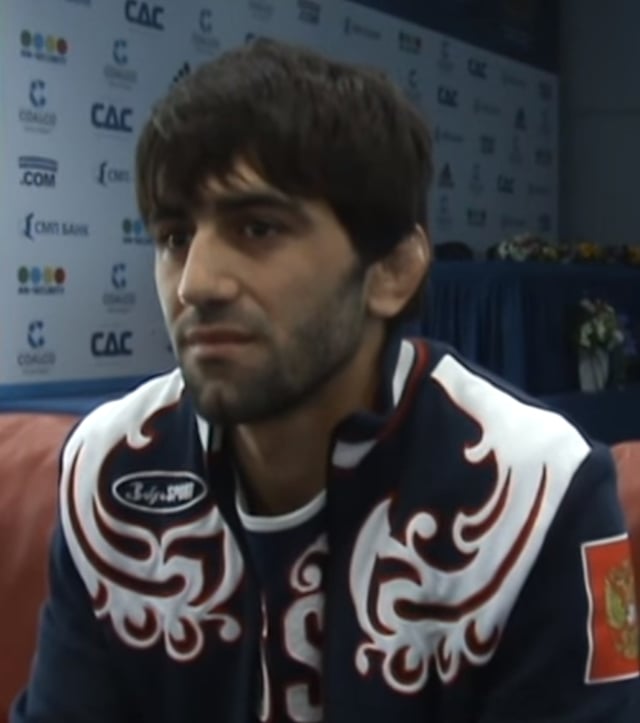
Russian-Circassian wrestler Beslan Mudranov won Russia's first gold medal at the Rio 2016 Olympics
Adyghe society prior to the Russian invasion was highly stratified. While a few princedoms in the mountainous regions of Adygeya were fairly egalitarian, most were broken into strict castes. The highest was the caste of the "princes", followed by a caste of lesser nobility, and then commoners, serfs, and slaves. In the decades before Russian rule, two princedoms overthrew their traditional rulers and set up democratic processes, but this social experiment was cut short by the end of Adyghe independence.
Language
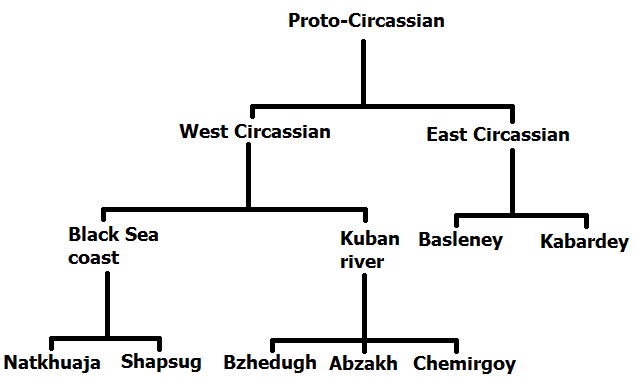
The Circassian dialects and sub-dialects development
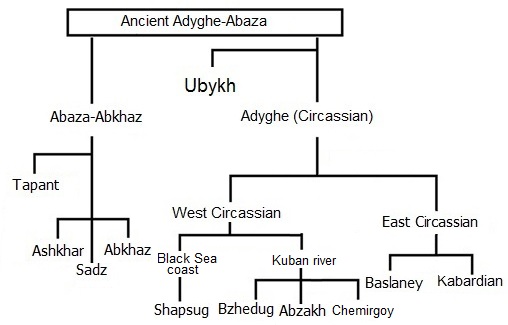
The isolated Northwest Caucasian language family
Circassians mainly speak the Circassian language, a Northwest Caucasian language with numerous dialects, the primary ones being Adyghe (West Circassian) and Kabardian (East Adyghe). West Adyghe language is based on Temirgoy (Chemirgoy) dialect, while East Adyghe language is based on Kabardian dialect. Circassians also speak Russian, Turkish, English, Arabic, and Hebrew in large numbers, having been exiled by Russia to lands of the Ottoman Empire, where the majority of them live today, and some to neighboring Persia, to which they came primarily through mass deportations by the Safavids and Qajars or, to a lesser extent, as muhajirs in the 19th century.[77][78][79][80]
Linguists divide the Northwest Caucasian languages into Circassian (including Kabardian), Ubykh (originally an Circassian dialect, theorised to be the original form of Circassian language), and Abazgi (Abkhaz-Abaza). Ubykh and Circassian are practically the same language. The Ubykhs lived on the Black Sea coast, around the city of Sochi, the capital of Circassia, north of Abkhazia.
Although related, Abazgi and Circassian are mutually unintelligible. Abazgi is spoken by the Abkhazians and the Abazins.The Abkhazians lived on the coast between the Circassians and the Georgians, were organized as the Principality of Abkhazia and were involved with the Georgians to some degree. The Abazins or Abaza, their relatives, lived north of the mountains and were involved with Circassia proper. They extended from the mountain crest northeast onto the steppe and partially separated the Kabardians from the rest. Sadz were either northern Abkhazian or eastern Abaza, depending on the source.
Walter Richmond writes that the Circassian language in Russia is "gravely threatened." He argues that Russian policy of surrounding small Circassian communities with Slavic populations has created conditions where Circassian language and nationality will disappear. By the 1990s, Russian had become the standard language for business in the Republic of Adygea, even within communities with Circassian majority populations.[81]
Religion
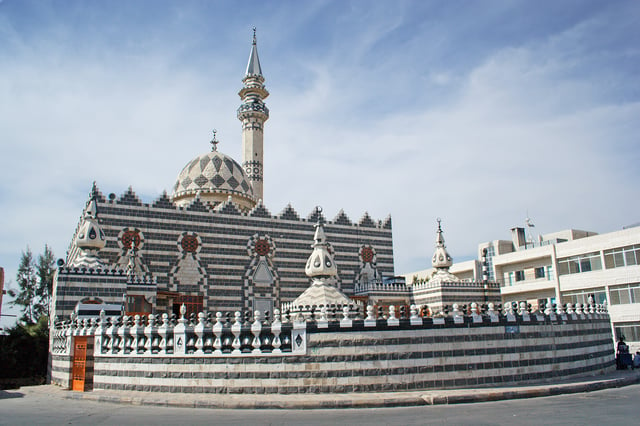
The mosque of Abu Darwish (Adyghe descendant), one of the oldest mosques in Amman and considered as a major landmark.
Ancestors of modern Adyghe people gradually went through following various religions: Monotheism with its Christianity, and then Islam.[82]
A small Muslim presence in Circassia has existed since the Middle Ages, but widespread Islamization occurred after 1717, when Sultan Murad IV ordered the Crimean Khans to spread Islam among the Circassians, with the Ottomans and Crimeans seeing some success in converting members of the aristocracy who would then ultimately spread the religion to their dependents.[84] However, despite the efforts of the Ottomans and their Crimean and Circassian clients, the masses of the Circassian people remained Christian and pagan, until the threat of Russian conquest impelled the majority of them to convert in order to cement defensive alliances with the Ottoman Empire and the Crimean Khanate to protect their independence.[84][85]
Significant Christian and pagan presence remained among some tribes such as the Shapsugs and Natukhai with Islamization pressures implemented by those loyal to the Caucasus Emirate.[86] Sufi orders including the Qadiri and Nakshbandi orders gained prominence and played a role in spreading Islam.[26]
Today, a large majority of Circassians remain Muslim, with minorities of atheists[26] and Christians.[87] Atheist Circassians tend to be of the younger generation (20–35 years old), in which they were found to constitute a quarter of Circassians in Kabardino-Balkaria.[26] Among Christians, Catholicism, originally introduced along the coasts by Venetian and Genoese traders, today constitutes just under 1% of Kabardins.[24] Some Circassians are also Orthodox Christian, notably including those in Mozdok[88] and some of those Kursky district.[23] Among Muslims, Islamic observance varies widely between those who only know a few prayers with a Muslim identity that is more "cultural" than religious, to those who regularly observe all requirements.[26]
Both Islam and the Habze are identified as national characteristics even by those that do not practice.[26] Today, Islam is a central part of life in many Circassian diaspora communities, such as in Israel, while in the Circassian homeland Soviet rule saw an extensive process of secularization, and there is wide influence of many social norms which contradict Islamic law, such as widespread observance of traditional pre-Islamic moral codes contradicting those of Islam, and norms like social alcohol consumption; in Israel, meanwhile, such non-Islamic social norms are not present.[87]
In the modern times, it has been reported that those who identify primarily as adherents of the native Habze faith (as opposed to another listed faith) constitute 12% of the population of Karachay-Cherkessia and 3% of the population of Kabardino-Balkaria.[89][25] There have also been reports of violence and threats against those "reviving" and diffusing the original Circassian pre-Islamic faith.[90][91] The relationship between habze and Islam varies between Circassian communities; for some, there is conflict between the two, while for others, such as in Israel, they are seen as complementary philosophies.[87]
Traditional social system
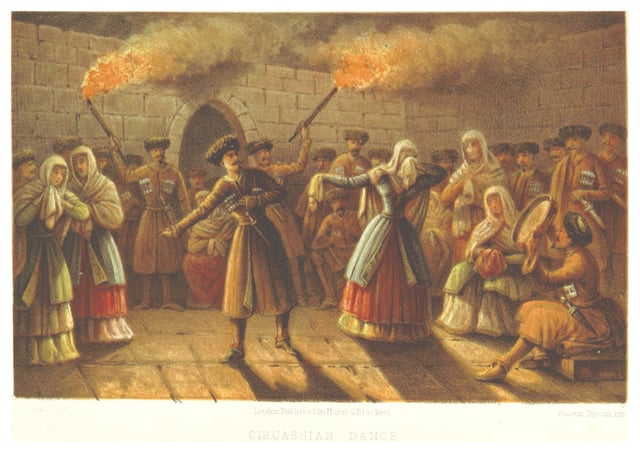
Circassian dance
Society was organized by Adyghe khabze, or Circassian custom.[92] Many of these customs had equivalents throughout the mountains. The seemingly disorganized Circassians resisted the Russians just as effectively as the organized theocracy of Imam Shamil. The aristocracy was called warq. Some aristocratic families held the rank of Pshi or prince and the eldest member of this family was the Pshi-tkhamade who was the tribal chief. Below the warq was the large class to tfokotl, roughly yeomen or freemen, who had various duties to the warq.
They were divided into clans of some sort. Below them were three classes approximating serfs or slaves. Of course, these Circassian social terms do not exactly match their European equivalents. Since everything was a matter custom, much depended on time, place, circumstances and personality. The three 'democratic' princedoms, Natukhai, Shapsug, and Abdzakh, managed their affairs by assemblies called Khase or larger ones called Zafes.
Decisions were made by general agreement and there was no formal mechanism to enforce decisions. The democratic princedoms, who were perhaps the majority, lived mainly in the mountains where they were relatively protected from the Russians. They seem to have retained their aristocrats, but with diminished powers. In the remaining 'feudal' princedoms power was theoretically in the hands of the Pshi-tkhamade, although his power could be limited by Khases or other influential families.
In addition to the vertical relations of class there were many horizontal relations between unrelated persons. There was a strong tradition of hospitality similar to the Greek xenia. Many houses would have a kunakskaya or guest room. The duty of a host extended even to abreks or outlaws. Two men might be sworn brothers or kunaks. There were brotherhoods of unrelated individuals called tleuzh who provided each other mutual support. It was common for a child to be raised by an atalyk or foster father. Criminal law was mainly concerned with reconciling the two parties. Adyghe khabze is sometimes called adat when it is contrasted to the kind of Islamic law advocated by people like Imam Shamil.
Traditional clothing

Traditional Circassian clothing
The traditional female clothing (Adyghe: Бзылъфыгъэ Шъуашэр, Bzıłfıǵe Ȿuaşer [bzəɬfəʁa ʂʷaːʃar]) was very diverse and highly decorated and mainly depends on the region, class of family, occasions, and princedoms. The traditional female costume is composed of a dress (Adyghe: Джанэр, Janer [d͡ʒaːnar]), coat (Adyghe: Сае, Saye [saːja]), shirt, pant (Adyghe: ДжэнэкӀакор, Jeneç'akuer [d͡ʒanat͡ʃʼaːkʷar]), vest (Adyghe: КӀэкӀ, Ç'eç' [t͡ʃʼat͡ʃʼ]), lamb leather bra (Adyghe: Шъохътан, Ȿuex́tan [ʂʷaχtaːn]), a variety of hats ({{lang-ady |ПэӀохэр}, Peꜧuexer} [paʔʷaxar]), shoes, and belts (Adyghe: Бгырыпхыхэр, Bğırıpxıxer [bɣərəpxəxar]).
Holiday dresses are made of expensive fabrics such as silk and velvet. The traditional colors of women's clothing rarely includes blue, green or bright-colored tones, instead mostly white, red, black and brown shades are worn. The Circassian dresses were embroidered with gold and silver threads. These embroideries were handmade and took time to complete as they were very intricate.
The traditional male costume (Adyghe: Адыгэ хъулъфыгъэ шъуашэр, Adığe X́uıłfıǵe Ȿuaşer [aːdəɣa χʷəɬfəʁa ʂʷaːʃar]) includes a coat with wide sleeves, shirt, pants, a dagger, sword, and a variety of hats and shoes. Traditionally, young men in the warriors times wore coat with short sleeves—in order to feel more comfortable in combat. Different colors of clothing for males were strictly used to distinguish between different social classes, for example white is usually worn by princes, red by nobles, gray, brown, and black by peasants (blue, green and the other colors were rarely worn).
A compulsory item in the traditional male costume is a dagger and a sword. The traditional Adyghean sword is called Shashka. It is a special kind of sabre; a very sharp, single-edged, single-handed, and guardless sword. Although the sword is used by most of Russian and Ukrainian Cossacks, the typically Adyghean form of the sabre is longer than the Cossack type, and in fact the word Shashka came from the Adyghe word "Sashkhwa" (Adyghe: Сашьхъуэ, Sas̨x́ue) which means "long knife". On the breast of the costume are long ornamental tubes or sticks, once filled with a single charge of gunpowder (called gaziri cartridges) and used to reload muskets.
Traditional cuisine

An old country house and traditional cuisine with Haliva (Хьэлжъо, Helɀwa) and Mataz (Мэтазэ, Metaze), two of the prominent traditional Adyghe snacks.
The Adyghe cuisine is rich with different dishes.[93][94] In the summer, the traditional dishes consumed by the Adyghe people are mainly dairy products and vegetable dishes. In the winter and spring the traditional dishes are mainly flour and meat dishes. An example of the latter is known as ficcin.
Circassian cheese is considered one of the more famous types of cheeses in the North Caucasus.
Variants of pasta are found. A type of ravioli may be encountered, which is filled with potato or beef.
On holidays the Adyghe people traditionally make Haliva (Adyghe: хьэлжъо, Helɀua) (fried triangular pastries with mainly Circassian cheese or potato), from toasted millet or wheat flour in syrup, baked cakes and pies. In the Levant there is a famous Circassian dish which is called Tajen Alsharkaseiah.[95]
Traditional crafts
The Adyghes have been famous for making carpets (Adyghe: пӏуаблэхэр, P'uablexer [pʷʼaːblaxar]) or mats worldwide for thousands of years.
Making carpets was very hard work in which collecting raw materials is restricted to a specific period within the year. The raw materials were dried, and based on the intended colours, different methods of drying were applied. For example, when dried in the shade, its colour changed to a beautiful light gold colour. If it were dried in direct sun light then it would have a silver colour, and if they wanted to have a dark colour for the carpets, the raw materials were put in a pool of water and covered by poplar leaves (Adyghe: екӏэпцӏэ, Yeç'epc'e [jat͡ʃʼapt͡sʼa]).
The carpets were adorned with images of birds, beloved animals (horses), and plants, and the image of the Sun was widely used.
The carpets were used for different reasons due to their characteristic resistance to humidity and cold, and in retaining heat. Also, there was a tradition in Circassian homes to have two carpets hanging in the guest room, one used to hang over rifles (Adyghe: шхончымрэ, Şxuençımre [ʃxʷant͡ʃəmra]) and pistols (Adyghe: къэлаеымрэ, Qelayeımre), and the other used to hang over musical instruments.
The carpets were used to pray upon, and it was necessary for every Circassian girl to make three carpets before marriage; a big carpet, a small carpet, and the last for praying as a prayer rug. These carpets would give the grooms an impression as to the success of their brides in their homes after marriage.[96]
Tribes
From the late Middle Ages, a number of territorial- and political-based Circassian tribes or ethnic entities began to take shape. They had slightly different dialects.
Dialects came to exist after Circassia was divided into princedoms (tribes) after the death of King Yinal of Circassia, who united Circassia for the last time before its short renuion during the Russo-Caucasian War. As the logistics between the princedoms became harder, each princedom became slightly isolated from one another, thus the people living under the banner of each princedom developed their own dialects. In time, the dialects they speak were named after their princedoms. After a longer while, the people began being called after the princedom which they live under the banner of. Therefore, there is a widespread misconception of these princedoms actually being tribes. Opposed to that, the notion "tribe" is non-existent in the Circassian culture.
At the end of the Caucasian War most Circassians were expelled to the Ottoman Empire, and many of the princedoms were destroyed and the people evicted from their historical homeland in 1864.
The main groups within the Circassian people are the Adygeans, Abzakh, Kabardians, and Cherkess. This does not include tribal subgroups.
Most Adyghe living in Circassia are Bzhedug, Kabardian, and Temirgoy, while the majority in diaspora are Kabardian, Abdzakh, and Shapsug. West Adyghe language is based on Temirgoy dialect, while East Adyghe language is based on Kabardian dialect.
The twelve stars on the Circassian flag symbolize the individual tribes of the Circassians; the nine stars within the arc symbolize the nine aristocratic tribes of Adygea, and the three horizontal stars symbolize the three democratic tribes. The twelve tribes are the Abdzakh, Besleney, Bzhedug, Hatuqwai, Kabardian, Mamkhegh, Natukhai, Shapsug, Temirgoy, Ubykh, Yegeruqwai, and Zhaney.[97]
| Geographical designation | Main dialect | Tribe[98][99] | Circassian name | Notes |
|---|---|---|---|---|
| Adygeans (Adyghe of Adygea) | West Adyghe | Abzakh (Abdzakh or Abadzekh[98]) | Абдзах, Abźax[aːbd͡zaːx] | Second largest Adyghe tribe in Turkey and the world, largest in Jordan, sixth largest in Russia |
| Bzhedug (Bzhedugh or Bzhedukh[98]) | Бжъэдыгъу, Bɀedıǵu[bʐadəʁʷ] | Third largest Adyghe tribe in Russia, lesser in other countries | ||
| Hatuqwai (Hatukay or Khatukai[98]) | Хьэтыкъуай, Hatıꝗuay[ħaːtəq͡χʷaːj] | Completely expelled from the Caucasus, found almost exclusively in Turkey, US, Jordan, and Israel | ||
| Mamkhegh | Мэмхэгъ, Мамхыгъ, Mamxıǵ[maːmxəʁ] | a large clan, but a small tribe | ||
| Natukhai (Notkuadj[98]) | Натыхъуай, Netıx́uay[natəχʷaːj], Наткъуадж, Netıx́uaj[natəχʷaːd͡ʒ] | Completely expelled from the Caucasus after the Caucasian War | ||
| Temirgoy (Chemgui or Kemgui[98]) | КIэмгуй, Ç'emguıy[t͡ʃʼamɡʷəj] | Second largest Adyghe tribe in Russia, lesser in other countries | ||
| Yegeruqwai (Yegerukay) | Еджэрыкъуай, Yejerquay[jad͡ʒarqʷaːj] | Completely expelled from the Caucasus | ||
| Zhaney (Jane or Zhan[98]) | Жанэ, Ƶane[ʒaːna] | Not found after the Caucasian War on a tribal basis | ||
| Shapsugs (Adyghe of Krasnodar Krai) | Shapsug (Shapsugh) | Шэпсыгъ, Шапсыгъ, Şapsıǵ[ʃaːpsəʁ] | Third largest Adyghe tribe in Turkey and the world, largest in Israel | |
| Ubykhians (Adyghe of Krasnodar Krai) | Ubykh Adyghe (extinct) and Hakuchi Adyghe | Ubykh | Убых, Wıbıx[wəbəx], Пэху | Completely expelled from the Caucasus, found almost exclusively in Turkey where most speak East Adyghe, and some West Adyghe (often Hakuchi sub-dialect) as well as Abaza |
| Kabardians (Adyghe of Kabardino-Balkaria) | Kabardian Adyghe[100] | Kabardians (Kabardinian, Kabardin, Kabarday, Kebertei, or Adyghe of Kabarda) | Къэбэрдэй, Qeberdey[qabardaj], Къэбэртай, Qebertay[qabartaːj] | Largest Adyghe tribe in Turkey (over 2 millions), Russia (over 500,000), and the world (3–4 million), second or third largest in Jordan and Israel |
| Cherkessians (Cherkess or Adyghe of Karachay-Cherkessia) | Besleney[100] (Beslenei[98]) | Беслъэней, Basłınıy[basɬənəj] |
Other Adyghe groups
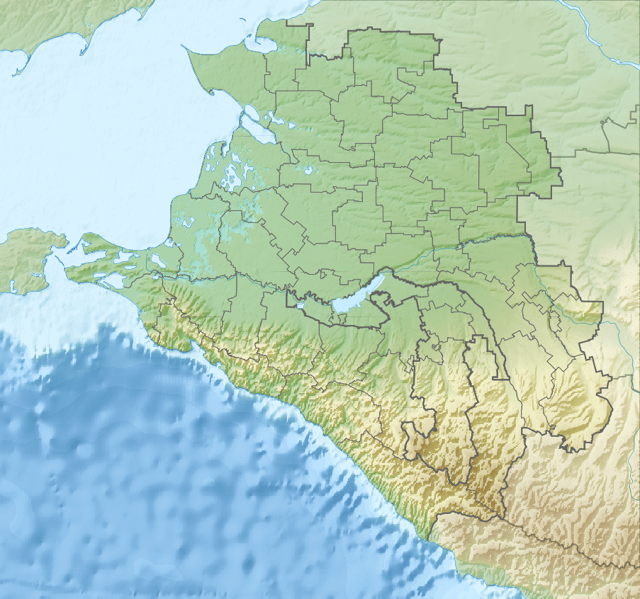
Approximate location of Circassian princedoms, Tsutsiev's Atlas
Small tribes or large clans that are included in one of the twelve Adyghe tribes:
| Name | Circassian name | Notes |
|---|---|---|
| Adele (Khatko) (Khetuk or Adali[98]) | ХьэтIукъу, Hat'uqu | Not found after the Caucasian War on a tribal basis, included in the Abzakh and Hatuqwai tribes |
| Ademey (Adamei or Adamiy) | Адэмый, Ademıy[aːdaməj] | Included in the Kabardian tribe |
| Guaye (Goaye) | Гъоайе, Ǵuaye | Not found after the Caucasian War |
| Shegak (Khegaik[98]) | Хэгъуайкъу, Xeǵueyqu | Not found after the Caucasian War |
| Chebsin (Čöbein[98]) | ЦIопсынэ, C'wapsıne | Not found after the Caucasian War |
| Makhosh (Mequash) (Mokhosh[98]) | Махошъ, Mexuaȿ[maːxʷaʂ] | A large clan, but not enough to be a separate tribe |
The Circassian tribes can be grouped and compared in various ways. The Kabarda occupied about a third of the north Caucasus piedmont from east of Circassia proper eastward to the Chechen country. To their north were the Nogai nomads and to the south, deeper in the mountains, were from west to east, the Karachays, Balkars, Ossetes, Ingushes, and Chechens. The Kabardians were fairly advanced, interacted with the Russians from the sixteenth century and were much reduced by plague in the early nineteenth century.
As for the Circassians proper, apparently called Kiakhs, some writers speak of twelve princedoms and some do not.
The narrow Black Sea coast was occupied, from north to south by the Natukhai, Shapsug, Ubykh, and the Abkhaz (Sadz sub-branch). The main part of the Natukhai and Shapsug princedoms located in north of the mountains. The Natukhai were enriched by trade since their coast was not backed by high mountains and opened onto the steppe.
The north slope was inhabited, from north to south, by the Natukhai, Shapsug, Abdzakh, and Abaza. They seem to have been the most populous princedoms after the Kabarda and its inland location gave then some protection from Nogai and Cossack raiding.
In the far west were three small princedoms that were absorbed into the Natukhai and disappeared. These were the Adele ru:Адале on the Taman peninsula and the Shegak and Chebsin (ru:Хегайки and ru:Чебсин) near Anapa.
Along the Kuban were the Natukhai, Zhaney, Bzhedug, Hatuqwai, and Temirgoy.
On the east, between the Laba and Belaya, from north to south, were the Temirgoy, Yegeruqwai (ru:Егерукаевцы), Makhosh (ru:Махошевцы), Besleney and Abaza. The Besleney were a branch of the Kabardians. The Tapanta (ru:Тапанта), a branch of the Abaza, lived between the Besleney and Kabardian princedoms on the upper Kuban. Along the Belaya River were the Temirgoy, the ill-documented Ademey (ru:Адамийцы) and then the Mamkhegh near the modern Maykop.
The Guaye (ru:Гуайе) are poorly documented. The Tchelugay lived west of the Makhosh. The Hakuch lived on the coast south of the Natukhai. Other groups are mentioned without much documentation. There are reports of princedoms migrating from one place to another, again without much documentation. Some sketch maps show a group of Karachays on the upper Laba without any explanation.
The princedoms along the Kuban and Laba rivers were exposed to Nogai and Cossack raiding while those in the interior had some protection. The three "democratic" princedoms were the Natukhai, Shapsug, and Abdzakh. They managed their affairs by assemblies while the other princedoms were controlled by "princes" or Pshi. Princedoms with remnants in the Caucasus are: Kabarda (the largest), the Temirgoy and Bzhedug in Adygea, and the Shapsug near Tuapse and to the north of Tuapsiysiy Rayon of Krasnodarskiy Kray. There are also a few Besleney and Natukhai villages, and an Abdzakh village.
Circassian diaspora
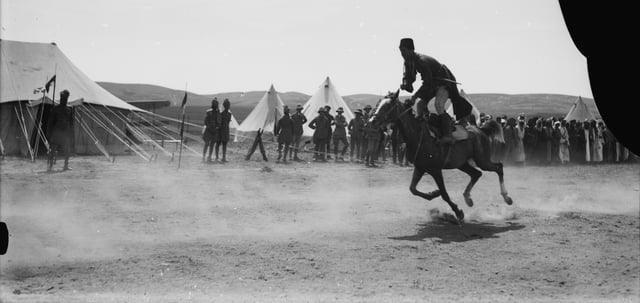
Adyghe horsemanship in Transjordan, April 1921
Much of Adyghe culture was disrupted after the conquest of their homeland by Russia in 1864. The Circassian people were subjected to ethnic cleansing and mass exile mainly to the Ottoman Empire, and to a lesser extent Qajar Iran and the Balkans. This increased the number of Circassians in the region and even created several entirely new Circassian communities in the states that got created after the dissolution of the Ottoman Empire. However, Adyghe have also lived outside the Caucasus region since the Middle Ages. They were particularly well represented in Turkey and Egypt.
The total number of Circassians worldwide is estimated at 8 million.
Turkey
Around half of all Circassians live in Turkey, mainly in the provinces of Samsun and Ordu (in Northern Turkey), Kahramanmaraş (in Southern Turkey), Kayseri (in Central Turkey), Bandırma, and Düzce (in Northwest Turkey).
Egypt
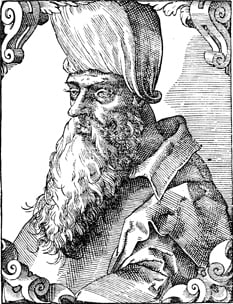
Tuman bay II (reigned 1516–1517) the last Mamluk sultan of Adyghe origins
During the 13th century the Mamluks seized power in Cairo. Some 15th-century Circassian converts to Islam became Mamluks and rose through the ranks of the Mamluk dynasty to high positions, some becoming sultans in Egypt such as Qaitbay, Mamluk Sultan of Egypt (1468–1496). The majority of the leaders of the Burji Mamluk dynasty in Egypt (1382–1517) had Circassian origins,[101] while also including Abkhaz, Abaza, and Georgian peoples whom the Arab sultans had recruited to serve their kingdoms as a military force. With the rise of Muhammad Ali Pasha (who ruled Egypt from 1805 to 1848), most senior Mamluks were killed by him in order to secure his rule and the remaining Mamluks fled to Sudan.
Most Circassian communities in Egypt were assimilated into the local population.[102] As of 2016 several thousand Adyghe reside in Egypt; in addition to the descendants of Burji Mamluks of Adyghe origin, there are many who descend from royal Circassian consorts or Ottoman pashas of Circassian origin as well as Circassian muhajirs of the 19th century.
Iran
Iran has a significant Circassian population.[103] It once had a very large community, but the vast amount were assimilated in the population in the course of centuries.[104][105][106] The Safavid (1501–1736) and Qajar (1789–1925) dynasties saw the importing and deporting of large numbers of Circassians to Persia, where many enjoyed prestige in the harems and in the élite armies (the so-called ghulams), while many others settled and deployed as craftsmen, labourers, farmers and regular soldiers. Many members of the Safavid nobility and élite had Circassian ancestry and Circassian dignitaries, such as the kings Abbas II of Persia (reigned 1642–1666) and Suleiman I of Persia (reigned 1666–1694). While traces of Circassian settlements in Iran have lasted into the 20th century, many of the once large Circassian minority became assimilated into the local population.[107] However, significant communities of Circassians continue to live in particular cities in Iran,[103] like Tabriz and Tehran, and in the northern provinces of Gilan and Mazandaran.[108][109]
Notable places of traditional Circassian settlement in Iran include Gilan Province, Fars Province,[110] Isfahan, and Tehran (due to contemporary migration). Circassians in Iran are the nation's second largest Caucasus-derived nation after the Georgians.[103]
Rest of Western Asia
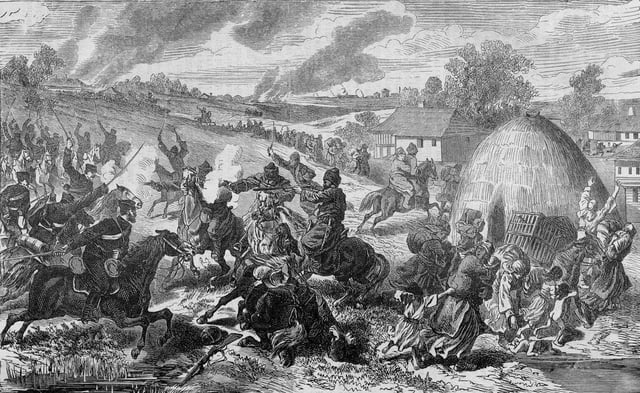
Serbian troops clashing with Circassians during the Serbian-Turkish War, 1876–1878
Significant communities live in Jordan,[111] Syria (see Circassians in Syria),[111] and smaller communities live in Israel (in the villages of Kfar Kama and Rehaniya—see Circassians in Israel).[111] Circassians are also present in Iraq. Baghdad, Sulaymaniyah, and Diyala comprise the country's main cities with Circassians,[112] though lesser numbers are spread in other regions and cities as well.
Rest of Europe
Out of 1,010 Circassians living in Ukraine (473 Kabardian Adyghe (Kabardin),[113] 338 Adygean Adyghe,[114] and 190 Cherkessian Adyghe (Cherkess)[115]—after the existing Soviet division of Circassians into three groups), only 181 (17.9%) declared fluency in the native language; 96 (9.5%) declared Ukrainian as their native language, and 697 (69%) marked "other language" as being their native language. The major Adyghe community in Ukraine is in Odessa.
There is a small community of Circassians in Serbia, Bosnia and Herzegovina and North Macedonia. A number of Adyghe also settled in Bulgaria in 1864–1865 but most fled after it became separate from the Ottoman Empire in 1878. The small community that settled in Kosovo (the Kosovo Adyghes) repatriated to the Republic of Adygea in 1998.
There are Circassians in Germany and a small number in the Netherlands.
North America
Numerous Circassians have also immigrated to the United States and settled in Upstate New York, California, and New Jersey. There is also a small Circassian community in Canada.
Sochi Olympics controversy

Circassians commemorate the banishment of the Circassians from Russia in Taksim, İstanbul
Adyghe organizations in Russia and the Adyghe diaspora around the world requested that construction at the site stop and that the Olympic Games not be held at the site of the Adyghe genocide, to prevent desecration of Adyghe graves. According to Iyad Youghar, who headed the lobby group International Circassian Council: "We want the athletes to know that if they compete here they will be skiing on the bones of our relatives."[116] The year 2014 also marked the 150th anniversary of the Circassian Genocide which angered the Circassians around the world. Many protests were held all over the world to stop the Sochi Olympics, but were not successful.
Depictions in art
See also
List of Circassians
Circassian beauties
Circassians in Israel
Idar of Kabardia






